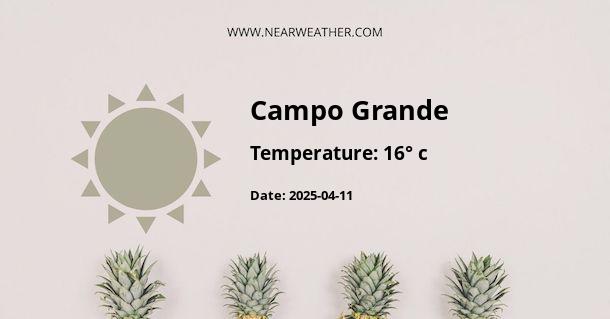Campo Grande, Argentina: Climate and Weather Overview
Located in the Córdoba province of Argentina, Campo Grande experiences a varied climate throughout the year, with distinct seasonal changes. Understanding the weather patterns of this region is essential for residents, tourists, and businesses alike. Let's delve into the in-depth analysis of the climate and weather in Campo Grande, Argentina, providing a comprehensive understanding of the atmospheric conditions and climate fluctuations in this region.
Annual Climate Overview
Campo Grande has a humid subtropical climate (Cfa in the Köppen climate classification). This results in a blend of distinct seasons, characterized by warm to hot summers and cool winters. Additionally, the region experiences precipitation fairly evenly throughout the year, with notable variations between the wet and dry seasons. Here's a detailed breakdown of the climate and weather patterns in Campo Grande throughout the year:
| Month | Average High (°C) | Average Low (°C) | Precipitation (mm) |
|---|---|---|---|
| January | 31 | 18 | 128 |
| February | 30 | 17 | 111 |
| March | 28 | 17 | 107 |
| April | 25 | 13 | 51 |
| May | 22 | 10 | 29 |
| June | 19 | 7 | 18 |
| July | 19 | 6 | 12 |
| August | 22 | 8 | 17 |
| September | 24 | 10 | 34 |
| October | 27 | 13 | 87 |
| November | 29 | 15 | 109 |
| December | 31 | 17 | 133 |
From the data, it's evident that Campo Grande experiences a notable variation in temperature and precipitation throughout the year. The summer months of January and February are characterized by high temperatures, with average highs reaching 31°C and significant precipitation, making it the wettest period. Conversely, winter in June and July sees relatively cooler temperatures and minimal precipitation, making it the driest period. Understanding these seasonal variations is crucial for planning outdoor activities, agricultural practices, and infrastructure development in the region.
Weather Extremes and Natural Hazards
While Campo Grande enjoys a moderate overall climate, it is not immune to weather extremes and natural hazards. Thunderstorms can occur in the summer months, potentially leading to flash floods in low-lying areas. Furthermore, intense heatwaves during the peak of summer can pose risks to public health and agricultural productivity. Hence, it's essential for residents and authorities to have robust disaster preparedness and response plans in place.
Impact on Agriculture and Economy
The climate and weather patterns in Campo Grande play a pivotal role in shaping the region's agricultural landscape and economy. The relatively even distribution of precipitation throughout the year provides favorable conditions for crop cultivation, with a focus on soybeans, maize, and wheat. Additionally, the distinct seasons allow for the cultivation of a variety of fruits and vegetables, contributing to the region's agricultural diversity. Understanding the climate fluctuations and their impact on agriculture is essential for optimizing crop yields and sustaining the local economy.
Conclusion
In conclusion, Campo Grande, Argentina, experiences a humid subtropical climate characterized by distinct seasons and moderate precipitation throughout the year. The climate exerts a significant influence on various aspects of life in the region, including agriculture, tourism, and infrastructure development. By comprehensively understanding the weather patterns and climate fluctuations in Campo Grande, residents and stakeholders can make informed decisions regarding resource allocation, disaster preparedness, and long-term planning, ensuring the sustainable development and resilience of the region.
A - Campo Grande's Latitude is -27.207701 & Longitude is -54.979771.
A - Weather in Campo Grande is 16° today.
A - Climate Conditions in Campo Grande shows clear sky today.
A - Humidity in Campo Grande is 81% today.
A - Wind speed in Campo Grande is 3.56 km/h, flowing at 122° wind direction. today.
